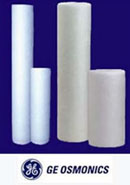About Water - Water Glossary
PH – Concentration of hydrogen commonly express in terms of ph scale. Low ph means to high hydrogen ion concentration and vice versa. A substance that when added to water increases the hydrogen ions (while lowering the ph) is called an acid. A substance that reduces the concentration of hydrogen ions is called a base.
PART’S PER MILLION- (PPM) Equivalent to milligrams per liter (mg/l).
PERMEATE- Water from which most of the dissolved solids have been removed by the process of reverse osmosis. PH Water (H2O) can dissociate into two ions: hydrogen (H+) and hydroxyl (OH-). These ions can also be added to water in combination with other oppositely charged ions. Thus, a solution of hydrochloric acid added to the water provides both H+ and the chloride anion, Cl-. The concentration of H+ in the water is a measure of water's acidity and the concentration of OH-, a measure of its alkalinity.
TURBIDITY- is a measure of the presence of colloidal matter in the water that remains suspended. Suspended matter in a water sample, such as clay, silt, or finely divided organic and/or inorganic matter will scatter the light from an incident light beam. The extent of scattering is expressed in Jackson or Nephelometric turbidity units (JTU and NTU)
RESIN- Synthetic organic ion exchange material, such as the high capacity cation exchange resin widely used in water softeners. Technical name - sulfonated co - polymer of styrene and divinyl benzene.
RESIDUAL- The amount of a specific material remaining in the water following a water treatment process. It may refer to material remaining as the result of incomplete removal such as hardness leakage, or to a substance meant to remain in the treated water such as residual chlorine.
1 2 3 4 5 6 7 8

